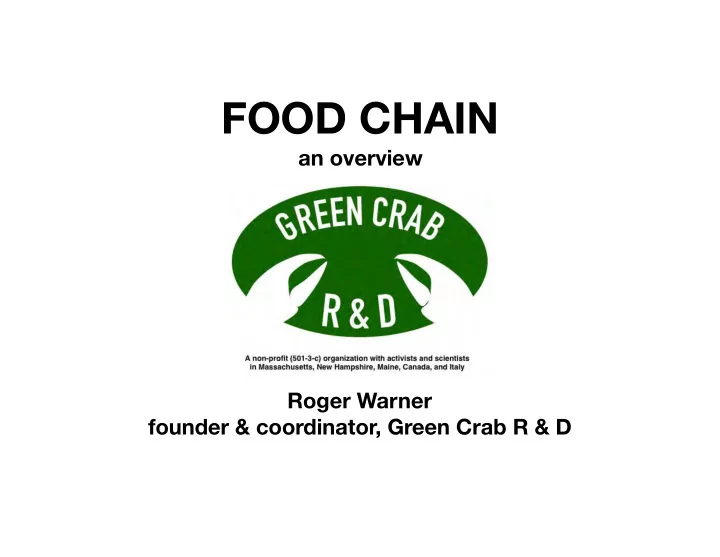

FOOD CHAIN an overview Roger Warner founder & coordinator, Green Crab R & D
Green Crab R & D a small, informal grassroots nonprofit organization for scientists, activists, and seafood industry people in Massachusetts, New Hampshire, Maine, the Canadian Maritimes, California, Washington State, and Venice Italy funding from Massachusetts Division of Marine Fisheries and other sources Presenters of The Crabby Awards, for excellence
Our small-scale hands-on projects include: Trapping (of course) Experimental production of soft-shell crabs Development of green crab food products with our partners Food tasting events & public outreach
But primarily: WE ARE AN INFORMATION-SHARING NETWORK Helping find measures to counteract the green crab invasion And working with our colleagues to jump-start a new branch of the seafood industry monthly email newsletter (from Roger Warner) www.greencrab.org + Facebook + Instagram pages (from Mary Parks — who has also put together the world’s first green crab cookbook)
The food chain concept is basic, and obvious Crabs grow with the intake of nutrients and minerals They are predators of small shellfish They are marauders of eelgrass But …
Green crabs are also prey Other critters eat them And, after death, crab carcasses break down into nutrients and minerals useful to others including humans
Predators in the wild include: Larger crustaceans (lobsters, blue crabs, big green crabs) Striped bass sea turtles, wol ffi sh and large finfish In their own way, green crabs are highly vulnerable
The commercial BAIT TRADE Mostly for tautog and conch/whelk traps from south of Cape Cod down to Virginia with tantalizing, and not-yet-fulfilled possibilities for lobster trap bait Steve Jury will address this and related subjects next
Our WORKING HYPOTHESIS not yet proven: Humans are the ultimate green crab predators If we are right, green crab population MIGHT be managed and reduced through commercial trapping to create a variety of gourmet foods and food additives Why do we think this might be true?
UMAMI Japanese word for flavor-enhancing Green crabs not only have a taste of their own similar to other crabs But they also AMPLIFY AND EXTEND the experience of other foods’ flavor and taste on the palate Green crabs create a long, pleasing flavor trail
from the Journal of Food Science, 2011
The main two umami-producing compounds are: Glutamic acid Aspartic acid
A USDA study on green crabs …
… shows that both aspartic acid and glutamic acid are present in green crabs in relatively large amounts
(A tip of the hat to the scientists here who know much, much more about food chemistry than I do, including Denise Skonberg Elizabeth Fairchild and Bouhee Kang)
Because of their umami flavor, and in spite of their small size and tough shells green crabs present four main food opportunities as gourmet food for humans
Stock or broth
Soft-shell green crabs a centuries-old recipe from Venice, Italy Brought to North America by Sophie St.-Hillaire and Luke Poirier Evangelized by Jonathan Taggart Conference co-organizers Marissa MacMahan and Gabby Bradt, Jonathan Taggart, Luke Poirier and others are working on increasing the e ffi ciency of soft-shell production
Various recipes based on green crab roe including a green crab version of “She-Crab Soup,” a bisque traditionally made with BLUE crab roe Jonathan Taggart has evangelized Mary Parks has produced a free cookbook of recipes Jamie Basset has some amazing ideas and photographs
… and, finally, green crab MINCE the soft innards, separated mechanically from the shell … which makes for great crabcakes! experimentally produced, in small quantities, by Bouhee Kang in the U. of Maine Orono food lab under the directions of Denise Skonberg (both of them here at this conference)
So … We have successful PROOF OF CONCEPT of four green crab recipe groups They all taste GREAT But none of them are in full-scale production YET … The fishing industry has not yet figured out how to make MONEY from green crabs
Mary Parks of Green Crab R & D will address the practical obstacles to large-scale production and profitability later on in this session.
Meanwhile … We need to ask ourselves … What if our hypothesis isn’t true? Or isn’t completely true? Or even if somewhat true, Can’t make a decisive di ff erence In reducing the wild green crab population?
Then we’d probably have to look for help elsewhere in the food chain.
We need to help the other NATURAL PREDATORS Especially striped bass. We need to outlaw commercial striper fishing and make it a recreational fish only if we want to give our clams and mussels a decent chance.
And we need to explore a new fascinating, if unproven hypothesis from Ed Grosholz (University of California / Davis), Andy Chang (Smithsonian Marine Invasives Research Lab) and others from their work at Stinson Beach. California (We hope to get Ed via video at 11:00 a.m. Thursday)
Their hypothesis in brief: Use crab traps with much finer mesh size, to get the tiny crabs and Let the big male crab CANNIBALIZE the rest! Let the big males become significant predators of their own species
It will take a few years of testing to prove or disprove this new hypothesis But it’s a fascinating idea
Conclusion: There’s an EMERGING CONSENSUS That we have to explore ALL MEANS to control green crabs Improve our trapping equipment, Get more e ffi cient at creating soft-shell crabs, Market green crabs with more sophistication And see how we can make crab-based derivative products from fertilizer on upwards.
Recommend
More recommend